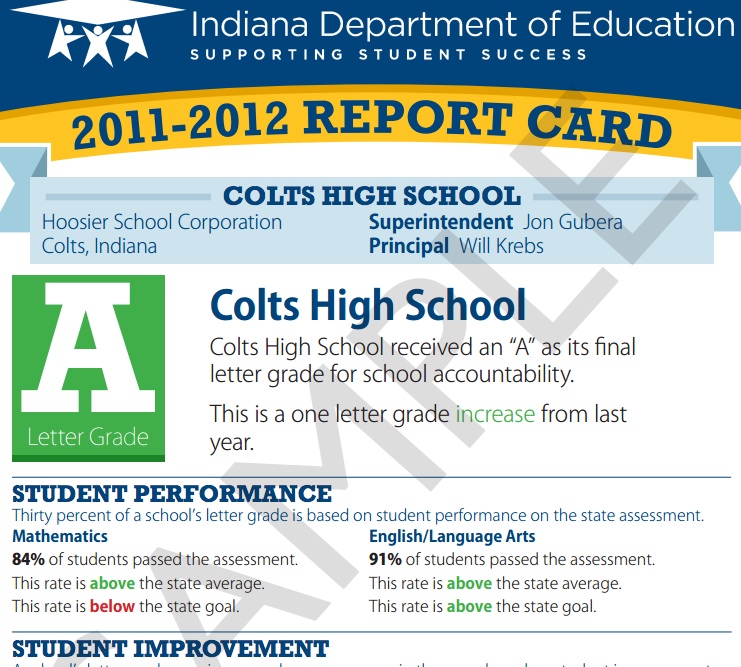How Tony Bennett's Last-Minute A-F Changes Lifted 165 Indiana School Grades

Kyle Stokes / StateImpact Indiana
Click here to view a map of 165 schools whose grades improved because of a change former state superintendent Tony Bennett's staff made to Indiana's A-F grading system.
Though it’s received the most media attention in the controversy that led to ex-Indiana schools chief Tony Bennett’s resignation, Christel House Academy was not the only school to benefit from state officials’ changes to Indiana’s fledgling school grading system in 2012.
After studying last year’s A-F rating data, a StateImpact analysis has identified 165 schools across the state — including Christel House — that saw higher final grades than they would have if Bennett’s staff hadn’t tweaked the formula roughly six weeks before releasing 2012’s results.
Take a look at this map and search this table to see if your school is one of those 165.
Bennett’s staff does not directly mention the change in emails the Associated Press published this month. From those messages, it’s not apparent state officials made the change with Christel House alone in mind.
The finding does, however, show how a relatively minor alteration to the A-F grading scale can have statewide implications.
- 'Lifting The Ceiling': How Bennett's Changes To The A-F System WorkStateImpact Indiana‘s Kyle Stokes explains the confusing but critical changes Tony Bennett’s staff made to the A-F grading system. Trust us — you want to know what the “subscore ceiling” is.Download
But it’s unclear whether what the finding could mean for Bennett’s legacy in Indiana or for the future of the state’s system for issuing performance ratings to schools — a system now undergoing its second re-write in as many years.
Does the finding support the case against Bennett, suggesting he manipulated the grading system to make these changes? Or does it bolster his defense, showing Bennett’s staff made a sincere effort to fix problems with the system that extend beyond Christel House’s grade?
The Half-Answered Question
The emails the Associated Press published two weeks ago only half-answered the question of how state officials managed to bump Christel House’s grade from a C to an A.
As School Matters blogger Steve Hinnefeld writes, the “loophole” Bennett’s staff found in the grading rules that allowed them to exclude Christel House’s poor high school level data only accounts for the school’s jump from a C to a B.Then, thanks to a tip from a commenter on his blog, Hinnefeld figured out how the school jumped from a B to an A. (He, along with the IU Center for Evaluation and Education Policy’s Terry Spradlin and The New America Foundation’s Anne Hyslop, helped check our math.)
The change, it turned out, didn’t just impact Christel House. Dozens of other schools were impacted.
The Change That Turned Many B’s Into A’s
Under Indiana’s A-F system, an elementary or middle school earns its grade from the average of its test scores in two subjects, English and math — their so-called English and math “subscores.”
Those subscores — like the final grades themselves — were calculated on a four-point scale. But schools could earn up to six total points if they earned bonuses for the number of students who made academic growth.
At least initially, though, state officials feared too many bonus points for one subject might cancel out a bad grade in another subject. They set up their calculations to limit schools’ ability to earn more than four points in any subject area, even with bonus points.
“The rationale for that,” says Hinnefeld, “was that [state officials] don’t really want to give an A to a school that was doing great in math but really poorly in English.”
In fact, the AP released an email dated September 13, 2012 showing a state education official factoring these limits into Christel House Academy’s grade. His initial run showed the school received a C, thanks in part to these bonus point limits.
Just five days later, someone posted new directions for calculating grades on the DOE’s website. This new document loosened the guidelines for counting bonus points toward a school’s grade.
—Andrew Rotherham, Bellwether Education Partners
(For those of you who want more detail on how the state’s formula changed and how we identified the 165 schools, we’ve set up a page explaining both processes in greater detail.)
Do These 165 Schools Deserve These Higher Grades?
Most of the schools’ grades increased from B’s to A’s after this change. A few others saw B’s when they would have received C’s if the grading system remained unchanged. No schools saw increases to C’s or D’s as a result, though.
Hinnefeld, who covered education at The Bloomington Herald-Times for a dozen years before getting out of newspapers, says he’s happy for the schools with which he’s familiar that benefited because of the change. In an interview, Hinnefeld said:
It’s probably better to do no harm with the grades and give people the benefit of a doubt and give schools the benefit a doubt. If you raise a few grades, that’s good, and if other schools didn’t benefit, then maybe they should’ve. But there is, I’m sure, from a quote-unquote reform perspective, an argument that maybe you are doing some harm with telling people they’re an A school when really they’re a B school.

Kyle Stokes/StateImpact Indiana (File)
Second graders at Christel House Academy play a math game in 2011.
So was Christel House an A school?
Bennett did not return phone calls requesting comment for this story. But when he spoke to StateImpact earlier this month, he said he not only felt it deserved an A — he advocated for the school to receive a high grade.
“Frankly, I made many comments where Christel House was an A school and I believe that any grading system you come up with should render that,” Bennett said.
But Andrew Rotherham, a co-founder of the non-profit group Bellwether Education Partners who blogs at Eduwonk, says there’s a fine line between fixing an anomaly in the grading system and showing favoritism for a school. He told StateImpact earlier this month:
It’s important that policymakers be able to pretty nimbly change things if there’s problems, rather than digging their heels in under political pressure to appear tough or being locked into a system that doesn’t work. These systems clearly don’t have a lot of credibility if they label really good schools as being low performing. It just erodes the system… You don’t have anybody who thinks [Christel House Academy] was a C school. People think it’s a better school.
The issue and where this gets complicated is based on the e-mails that have been released… it does appear that rather than just trying to fix that glitch, there was then an effort to say, ‘How do we get this to an A school?’ That’s more problematic.
Rotherham, however, has written that Bennett’s actions were not bad enough to warrant his resignation and that press coverage of the controversy has been “overblown.”
‘Transparent’ Or ‘Secretive’ Process?
—Terry Spradlin, IU’s Center for Evaluation & Education Policy
The whole process [of setting up the rating system] was a public-iterated process. We believe we had the concepts right but frankly there were some nuances to the system that we had to address. We did it, but I would argue that there wasn’t anything secretive about any of this… This is one of those things where obviously people will formulate their own opinions. I don’t think you or anyone else has ever accused us of being secretive or hiding from people or anything like that.
But even those who support either the former Indiana schools chief or A-F grading say a lack of transparency was a problem.
Policy analyst Anne Hyslop, who researches school accountability, says it’s not clear that Bennett’s staff made schools aware of the changes, undercutting their argument that they were simply trying to improve the grading system. She said in an interview:
There could be a good reason for [the change in counting the bonus points.] You really want to focus on school growth — which is where the bonus points come from and allow the schools to get such high grades. By removing the cap, schools are getting their full bonus points for having high growth and it would encourage schools and educators in the future to shoot for that.
You can make that explanation, but by not making publicly making that announcement, I think it undermines faith in accountability system and makes people question whether other changes were made that didn’t have as reasonable an explanation.
What Comes Next?
Leaders of the Indiana General Assembly and current schools chief Glenda Ritz have launched parallel investigations into the 2012 grades. While Ritz would only say last week her staff had found “manipulation” of those grades, she said the investigation would cause “great delays” in the release of this year’s A-F ratings.
“There’s just a cloud of doubt and skepticism” surrounding A-F grading now, says IU’s Terry Spradlin. He told StateImpact:
It was reasonable that there would be multiple iterations, simulations, projections and changes until there’s confidence in the system. A lot of public schools received better scores than initially projected. But the bottom line is this: With this revelation of information about apparent manipulation of the system to benefit a few schools, even though a large number of schools benefited over the horizon of the changes until the accountability system was finalized… the level of trust in the system certainly is in doubt.
But Gov. Mike Pence and key lawmakers have also expressed their desire to continue A-F grading, though a forthcoming re-write of the rating system means state officials will give out future grades based on new metrics.
Podcast: Play in new window | Download





